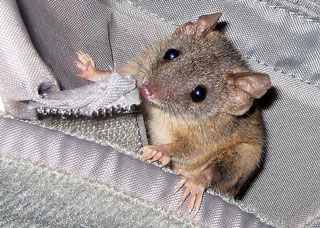Four Things Mice Don’t Want You to Know!
By Chris Williams on July 10, 2014.
 1. When we travel around your house at night, we pee everywhere we go.
1. When we travel around your house at night, we pee everywhere we go.
Mice aren’t much for established toilet stops. They pee and poop all the time, whenever and wherever they feel the urge. They tend to dribble urine as they move along. Mice will pee next to, or even in, their own nests. One way that exterminators check for rodent infestations is to use a black light since mouse urine glows under ultraviolet light. Besides the pee, a single mouse will leave about 70 droppings a day, randomly along its travel route.
Accumulations of mouse droppings and urine can contain allergens and disease particles which can become airborne and can be inhaled when a nesting site is cleaned or disturbed.
2. You know that chewed place around the laundry room door frame that you blamed on the dog? That was us.
A mouse will chew on any material that is softer than its teeth. They can chew through plasterboard, wood, vinyl siding, and fiberboard. The goal of most of their chewing is to gain access to a space that looks interesting for a nest site or as a source of food. If a mouse can find an edge or a corner that it can bite with its teeth, it can gnaw an opening big enough to get the rest of its body through…and that hole only needs to be about the size of a dime.
3. Yes, we also chewed that hole in your favorite nightgown.
We needed some fabric and it really is soft. We also borrowed some stuffing out of that throw pillow you like.
Mice make their nests of whatever small, soft materials the female can find, such as: carpet fibers, feathers, plastic, bits of fabric, shredded paper or paper towels, toilet paper or tissues, dryer lint, cotton balls, bits of string or yarn, and grass or leaves if available. The nest is a loose assemblage that may also contain bits of hoarded food.
4. We like to nest in that pan drawer under your stove.
We’ve had a nest in the back corner for a long time but you don’t see us since you never take out those pans anymore. If you looked more closely, you might recognize your nightgown!
Most new mouse infestations are centered in the kitchen where there is a ready supply of food, often in the form of crumbs, dropped food scraps, garbage, a greasy stove, or dry pet food left out. Besides the stove pan drawer, the most likely places to find mouse nests in a kitchen are in the back corners of lower kitchen cabinets, in the cabinet under the sink, and underneath the stove or refrigerator.
Photo credit: Jan Tilden / Foter / Creative Commons Attribution-NonCommercial-NoDerivs 2.0 Generic (CC BY-NC-ND 2.0)